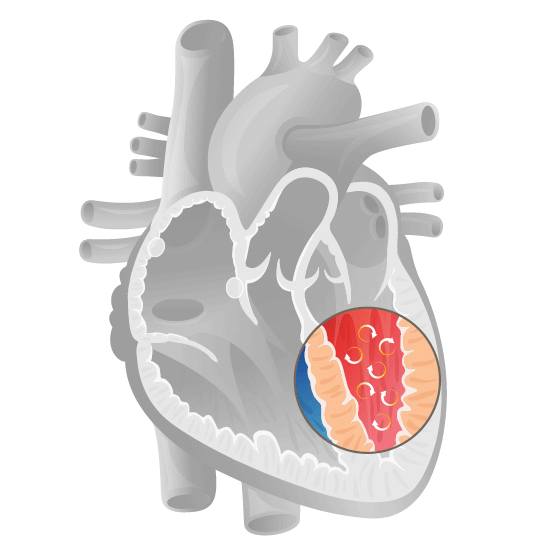Ventricular fibrillation is a life-threatening cardiac arrhythmia that occurs suddenly and without warning. It causes the heart to beat extremely fast, which stops it from pumping blood correctly, meaning the body does not get enough oxygen. This causes unconsciousness within seconds and requires immediate intervention. Without medical assistance, the lack of oxygen to the brain can cause irreversible brain damage after five minutes, which, in the worst case, can be fatal.

Overview
Ventricular fibrillation is a life-threatening cardiac arrhythmiawhere the heart beats at a rate of more than 300 beats per minute. This causes the heart to stop pumping properly, which is tantamount to a cardiac arrest. This means the body is not getting enough oxygen, which leads to a sudden loss of consciousness. Without immediate medical intervention, ventricular fibrillation leads to irreversible brain damage within a few minutes and, in the worst case, to death. Rapid action must be taken to save the life of the person affected.
In contrast to ventricular fibrillation, which affects the ventricles, atrial fibrillation affects the atria of the heart and is generally not as life-threatening. Ventricular flutter often precedes ventricular fibrillation and is characterised by a regular but very fast heartbeat, while ventricular fibrillation involves a more chaotic heart rhythm and tends to be more fatal.
Causes and risk factors
The most common cause of ventricular fibrillation is coronary heart disease, which is where narrowed or blocked coronary arteries lead to circulatory disorders. Other risk factors are heart attacks, which are caused by a blockage of the coronary arteries and damage the heart tissue, and cardiomyopathy, in which the heart muscle is thickened, enlarged or stiffened and the electrical activity of the heart is impaired as a result. Heart failure, which occurs when the heart muscle is unable to pump enough blood around the body, can also lead to structural changes in the heart that increase the risk of ventricular fibrillation. Congenital heart defects impair the electrical conduction of the heart and also increase the risk. Electrolyte disturbances, in particular an imbalance of potassium and magnesium, can disturb the electrical activity of the heart. In addition, certain medications, especially anti-arrhythmics, and drug misuse, such as the use of cocaine and amphetamines, can trigger ventricular fibrillation. All these factors affect the electrical stability of the heart and can lead to an uncontrolled, chaotic heartbeat, which increases the risk of ventricular fibrillation.
Symptoms
A person with ventricular fibrillation will suddenly collapse. This is usually accompanied by a rapid loss of consciousness within a few seconds. During the physical examination, the person’s pulse can no longer be felt and normal breathing stops. These symptoms occur because the heart completely loses its ability to pump as a result of the chaotic and extremely fast heartbeat. As a result, the body is no longer supplied with sufficient oxygen-rich blood. Within a very short time, the lack of oxygen means that the brain can no longer function properly, resulting in an immediate loss of consciousness.
Diagnosis
Ventricular fibrillation is diagnosed by a cardiology specialist using various methods. An electrocardiogram (ECG) shows the typical presentation of ventricular fibrillation with chaotic, rapid heartbeats. A physical examination confirms the suspicion by the absence of a pulse and respiration. The medical history can also provide information about previous heart problems or risk factors that could have triggered ventricular fibrillation.
Treatment
The immediate treatment for ventricular fibrillation is defibrillation. Immediate use of a defibrillator will end ventricular fibrillation and should be performed by a non-medic using an automated external defibrillator (AED) if available. If no defibrillator is available, chest compressions must be started immediately. Chest compressions should be performed at a rate of 100 to 120 per minute. Studies show that chest compressions are more important than ventilation, which is why the new guidelines recommend that people on their own should not administer rescue breaths and should concentrate on chest compressions instead. In the long term, the cause of ventricular fibrillation is treated after the patient has been successfully resuscitated. Implantable defibrillators are often used to prevent future episodes and minimise the risk of ventricular fibrillation recurrence.
Prevention
Various measures can be taken to prevent ventricular fibrillation. This includes regular treatment of heart disease in order to ensure coronary heart disease and other heart problems are managed effectively. Lifestyle changes such as a healthy diet, regular exercise and giving up smoking are also important preventive measures. Medication can also help to stabilise the heart rhythm. Implantable defibrillators can be life-saving for high-risk patients, as they recognise the onset of ventricular fibrillation and defibrillate immediately.


